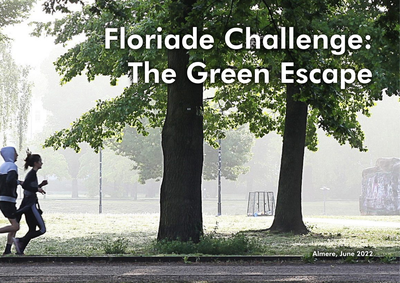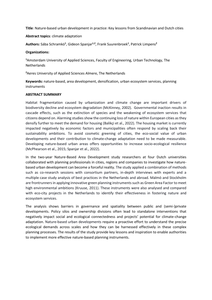Almere is a green city where the greenery extends into the centre through a framework of nature, forests, parks and canals. With this green environment, Almere fulfils an important condition for a liveable city, where it is pleasant to live and work. An important goal for the municipality is to challenge its residents to develop a healthy lifestyle by using that green framework.But what really motivates Almeerders to go outside to exercise, enjoy the surroundings and meet each other? Are there sufficient green meeting or sports facilities nearby? Could the routes that connect the living and working environment with the larger parks or forests be better designed? And can those routes simultaneously contribute to climate adaptation?With the Green Escape Challenge, we invited students and young professionals to work on these assignments together.
DOCUMENT

Abstract from AMS Scientific Conference '24, Amsterdam, Netherlands.In the two-year Nature-Based Area Development study researchers at four Dutch universities collaborated with planning professionals in cities, regions and companies to investigate how nature-based urban development can become a forceful reality. The study applied a combination of methods such as co-research sessions with consortium partners, in-depth interviews with experts and a multiple case study analysis of best practices in the Netherlands and abroad.Keywords: nature-based, area development, densification, urban ecosystem services, planning instruments
DOCUMENT

This article will explore the Cradle to Cradle (C2C) framework for urban environments, focusing on the perception, utilization and maintenance of parks. The case study explores the perception of urban flora and the value of greenery in everyday life in The Netherlands. The reflection section addresses the difference between conventional and C2C approaches to greenery on the one hand and current green management policies and public opinion on the other hand. The author reflects on how urban planning policies can be better geared towards public awareness of C2C, and towards the implementation of ecologically benign management of urban flora. It is proposed that an implementation of urban green management consistent with C2C is feasible and desirable. It is feasible given the favorable shifts in public opinion in relation to urban sustainability, and it is desirable due to the basic cost-benefit analysis and increased need for urban sustainability. This is a post-peer-review, pre-copyedit version of an article published in Urban Ecosystems. The final authenticated version is available online at: https://doi.org/10.1007/s11252-015-0468-2 https://www.linkedin.com/in/helenkopnina/
MULTIFILE

While the optimal mean annual temperature for people and nations is said to be between 13 °C and 18 °C, many people live productive lives in regions or countries that commonly exceed this temperature range. One such country is Australia. We carried out an Australia-wide online survey using a structured questionnaire to investigate what temperature people in Australia prefer, both in terms of the local climate and within their homes. More than half of the 1665 respondents (58%) lived in their preferred climatic zone with 60% of respondents preferring a warm climate. Those living in Australia's cool climate zones least preferred that climate. A large majority (83%) were able to reach a comfortable temperature at home with 85% using air-conditioning for cooling. The preferred temperature setting for the air-conditioning devices was 21.7 °C (SD: 2.6 °C). Higher temperature set-points were associated with age, heat tolerance and location. The frequency of air-conditioning use did not depend on the location but rather on a range of other socio-economic factors including having children in the household, the building type, heat stress and heat tolerance. We discuss the role of heat acclimatisation and impacts of increasing air-conditioning use on energy consumption.
MULTIFILE

Since it is insufficiently clear to urban planners in the Netherlands to what extent design measures can reduce heat stress and which urban spaces are most comfortable, this study evaluates the impact of shading, urban water, and urban green on the thermal comfort of urban spaces during hot summer afternoons. The methods used include field surveys, meteorological measurements, and assessment of the PET (physiological equivalent temperature). In total, 21 locations in Amsterdam (shaded and sunny locations in parks, streets, squares, and near water bodies) were investigated. Measurements show a reduction in PET of 12 to 22 °C in spaces shaded by trees and buildings compared to sunlit areas, while water bodies and grass reduce the PET up to 4 °C maximum compared to impervious areas. Differences in air temperature between the locations are generally small and it is concluded that shading, water and grass reduce the air temperature by roughly 1 °C. The surveys (n = 1928) indicate that especially shaded areas are perceived cooler and more comfortable than sunlit locations, whereas urban spaces near water or green spaces (grass) were not perceived as cooler or thermally more comfortable. The results of this study highlight the importance of shading in urban design to reduce heat stress. The paper also discusses the differences between meteorological observations and field surveys for planning and designing cool and comfortable urban spaces. Meteorological measurements provide measurable quantities which are especially useful for setting or meeting target values or guidelines in reducing urban heat in practice.
DOCUMENT

Cities worldwide are growing at unprecedented rates, compromising their surrounding landscapes, and consuming many scarce resources. As a consequence, this will increase the compactness of cities and will also decrease the availability of urban green space. In recent years, many Dutch municipalities have cut back on municipal green space and itsmaintenance. To offer a liveable environment in 30 to 50 years, cities must face challenges head-on and strive to create green urban areas that build on liveable and coherent sustainable circular subsystems.
DOCUMENT

More and more people worldwide live in urban areas, and these areas face many problems, of which a sustainable food provision is one. In this paper we aim to show that a transition towards more sustainable, regionally organized food systems strongly contributes to green, livable cities. The article describes a case study in the Dutch region of Arnhem–Nijmegen. Partners of a network on sustainable food in this region were interviewed on how they expect the food system to develop, and in design studies possible futures are explored. Both the interviews and the designs give support to the idea that indeed sustainable food systems can be developed to contribute to green livable cities. They show that the quality and meaning of existing green areas can be raised; new areas can be added to a public green system, and connections with green surroundings are enforced. They also show that inhabitants or consumers can be stimulated to become so called food citizens, highlighting that the relation of food systems and livable cities is a very close one.
DOCUMENT

Blue-green roofs have been utilized and studied for their enhanced water storage capacity compared to conventional roofs or extensive green roofs. Nonetheless, research about the thermal effect of blue-green roofs is lacking. The goal of this research is to study the thermal effect of blue-green roofs in order to assess their potential for shielding the indoor environment from outdoor temperature extremes (cold- and heat-waves). In this field study, we examined the differences between blue-green roofs and conventional gravel roofs from the perspective of the roof surface temperatures and the indoor temperatures in the city of Amsterdam for late 20th century buildings. Temperature sensor (iButtons) values indicate that outside surface temperatures for blue-green roofs are lower in summer and fluctuate less during the whole year than temperatures of conventional roofs. Results show that for three warm periods during summer in 2021 surface substrate temperatures peaked on average 5°C higher for gravel roofs than for blue-green roofs. Second, during both warm and cold periods, the temperature inside the water crate layer was more stable than the roof surface temperatures. During a cold period in winter, minimum water crate layer temperatures remained 3.0 o C higher than other outdoor surface temperatures. Finally, also the variation of the indoor temperature fluctuations of locations with and without blue-green roofs have been studied. Locations with blue-green roofs are less sensitive to outside air temperature changes, as daily temperature fluctuations (standard deviations) were systematically lower compared to conventional roofs for both warm and cold periods.
DOCUMENT

This booklet reports on experiments carried out by Van Hall Larenstein University of Applied Sciences in the context of the VALUE project. It consists of three parts. The first two chapters describe some experiments carried out in the Dutch town of Amersfoort and the students’ input and approach. This is followed by an intermezzo on sources of inspiration outside the Netherlands and examples of the way urban green spaces and elements can provide an impulse for towns and cities. The final two chapters concern the way such a green strategy can be designed in Dutch urban settings. Chapter 5 discusses how local governments can use the added value provided by urban green spaces for new investments:value capturing. Chapter 6 focuses on a new type of planning: Planning by Surprise, which combines dreams and pragmatism. The photo essay at the centre of the book tells the story of the many sides of green spaces in towns and cities. Unintentional, intentional, planned, dreamed of, drawn,remembered, pictured, developed: Planning by Surprise.
DOCUMENT

Due to climate change the frequency of extreme precipitation increases. To reduce the risk of damage by flooding, municipalities will need to retrofit urban areas in a climate-resilient way. To justify this investment, they need insight in possibilities and costs of climate-resilient urban street designs. This chapter focused on how to retrofit characteristic (Dutch) typologies of urban residential areas. For ten cases alternative street layouts were designed with a determination of the life cycle costs and benefits. All designs are resilient to extreme rain events. The results show that most flat urban typologies can easily be retrofitted in a climate-resilient way without additional costs compared to the standard way of retrofitting. Climate proofing sloping areas are highly dependent on the situation downstream. When there is no space downstream to divert the water into waterways or parks, costs to provide storage easily rise above traditional levels for retrofitting. In addition to reducing flood risk, for each case one variant includes resilience to extreme heat events making use of green. The life cycle costs and benefits of the green variants showed that especially green designs in high-density urban areas result in a better value for money.
MULTIFILE
